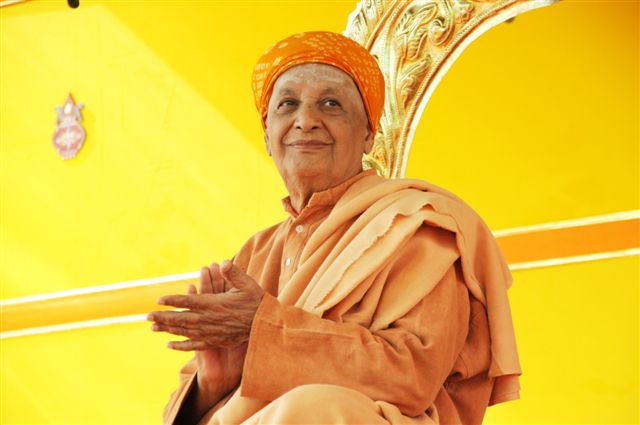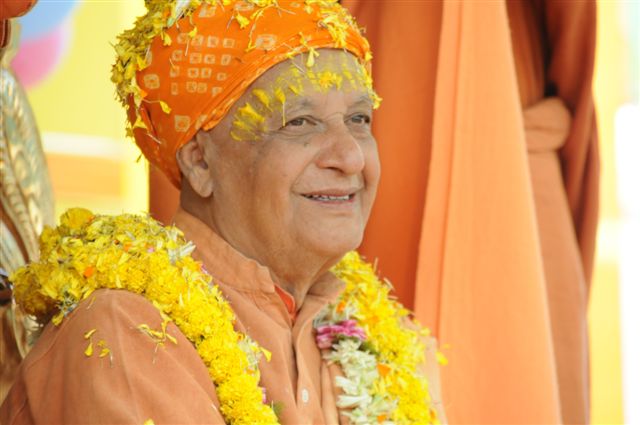Satsang by Swami Sivananda
Intense devotion to one’s guru and faithful adherence to his teachings are the most essential qualifications of true discipleship. It is this shraddha, faith, and gurubhakti, devotion to guru, that bring about rapid spiritual progress and fruition of one’s sadhana. A disciple without devotion to his guru is like a flower without fragrance, a well without water, a cow without milk or a body without life. A true aspirant rejoices in the practice of guru bhakti yoga. Without taking recourse to this yoga one cannot practise the other yogas. Whatever may be acquired by asceticism, renunciation, charity, auspicious acts or by other yogas, all these are speedily acquired by practising guru bhakti yoga. It is the magic wand in the hands of the disciple to cross the ocean of samsara.
Guru bhakti will make possible all that is impossible; the unattainable can be attained by guru bhakti. However, this treasure is not acquired in a day. Guru bhakti is not a system that can be taught by lectures or correspondence courses. The disciple has to cultivate it gradually and painstakingly. He must increase it day by day. It develops through constant and earnest prayer in the secret chamber of the heart. The student should live under a preceptor for many years and lead a rigorous life of austerity, discipline, celibacy and deep meditation. He must make himself perfectly blind to the human aspects of the guru. Then he will develop true guru bhakti.
Nava vidha guru bhakti
Just as there are nine forms of bhakti, there are also nine aspects of guru bhakti yoga:
1. The real and lasting aspiration to practise guru bhakti yoga.
2. Absolute faith in the thoughts, words and actions of the satguru.
3. Perfect obedience in carrying out guru’s commands.
4. Doing namaskar or paying obeisance with humility, and repeating his name.
5. Performing personal service to the satguru without expectation of fruits.
6. Daily worshipping the lotus feet of the satguru with bhava and devotion.
7. Self-surrendering or dedication of tana, body, mana, mind, and dhana, wealth, in the cause of the divine mission of the guru.
8. Meditation on the holy feet of the guru for obtaining his benign grace and mercy.
9. Hearing his teachings and sincerely practising them.
Deification of the guru is a mysterious and powerful method of obtaining his grace. When you deify him, you see only the storehouse of perfection in him. Even if you cannot understand his actions, do not misunderstand them. Be humble and silent. Wait patiently. Eventually you will be rewarded with light.
Force of faith
Shraddha or faith is that power which sustains the aspirant on the path towards perfection. It supports him during tests and trials, temptations and pitfalls and in overcoming seemingly insurmountable obstacles. Therefore, always keep alive your shraddha and bhakti in your gurudeva. Let your faith be unsullied and staunch. Your efforts to attain the true goal of life will be crowned with success.
The aspirant, before he desires the grace of the master, should deserve it. The supply of divine grace comes only when he is fit to receive it. Guru’s grace descends upon those who feel utterly humble and faithful to him. Faith is confidence and trust in guru. Faith is firm conviction of the truth of what is declared by the preceptor by way either of testimony or authority, without any other evidence or proof. The disciple who has faith in the guru argues not, thinks not, reasons not and cogitates not. He simply obeys, obeys and obeys.
Once Sri Shankaracharya wanted to test the devotion of his disciple Padmapada. The river Kaveri was in flood. Sri Shankara was standing on one bank of the river and Padmapada was standing on the other bank. Sri Shankara beckoned Padmapada to come to him immediately. There was no boat. Padmapada did not care, he at once jumped into the river even though he did not know how to swim. This is real devotion. Through the grace of Shankaracharya, Padmapada walked quite easily on the river. At each step a lotus flower appeared. This is how he got the name Padmapada, which means ‘lotus in the feet’.
Devotion to guru trains your heart and prepares for devotion to God. Guru bhakti draws down the grace of the preceptor and ultimately bestows illumination and bliss.
Die to live
Die at the lotus feet of guru, give up your ego and die, only so you may live again the true divine life. Life is no life if not enlivened and made divine by the transforming grace of guru.
If you want to drink the spiritual nectar of immortality which flows from the holy lips of the guru, you will have to be an embodiment of humility and meekness. The lower nature of mind must be thoroughly transformed. The aspirant says to his preceptor: “I want to practise yoga. I want to enter into nirvikalpa samadhi. I want to sit at your feet. I have surrendered myself to you.” But he does not want to change his lower nature and habits, old character, behaviour and conduct.
Let the disciple’s first lesson be obedience to guru. The disciple has to serve the guru and do everything the guru commands without grudging and without using his intellect. When the guru gives an order, the disciple should obey implicitly. Such obedience to guru is necessary. This is the spirit of nishkama karma, karma done not for the pleasure of the person doing it but because it is the holy command of the preceptor. Then only the impurities of the mind such as kama, passion, krodha, anger and lobha, greed, are destroyed.
One’s individual ego, preconceived notions, pet ideas and prejudices and selfish interests should be given up. All these stand in the way of carrying out the teachings and instructions of one’s guru. If you want to be a true disciple, you should follow the instructions of your guru to the very letter and spirit. If you make a promise to your guru, you should fulfil it even at the cost of your life.
If you fail to ask the wise what you know not, you will remain a dunce throughout your life. Sit at the lotus feet of your guru with bhava and faith. Serve him with sincerity, humility and love. Prostrate before him morning and evening. Clear your doubts. Hear the shrutis from him. Reflect. Meditate. Behold the supreme, transcendental light of lights. Drink deep the wisdom-nectar and attain immortality.
The best way you can express your real adoration to the preceptor is to actually emulate his noble example. Have him as your ideal. Struggle to build yourself upon that model. This will be the most effective puja of your guru and the most pleasing guru dakshina.
Shampoo my waist with your feet!
Once a saint, in order to test his disciple, ordered him to shampoo his waist by his feet. The saint said, “My waist is paining. Will you, my dear disciple, shampoo it with your feet?” The disciple said, “Maharaj! How am I to put my feet on your holy person? That is a great sin.” The saint replied, “But are you not, in thus disobeying me, putting your feet on my tongue?”
One should learn a lesson from this example. The disciple should not exercise his intellect in carrying out the orders of his guru. He should discard impertinence and develop true and lasting devotion. One should serve a saint in every way, serve him physically, meditate on him, carry out his orders without delay, try to serve his mission, and so forth. One should have unflinching faith. Mysterious are the ways of a saint. The services that he takes from you are for your own benefit. He himself wants nothing. By giving various orders and testing you in various ways, he makes you a fit vessel for the reception of enlightenment.




